The Floating Docks Market is estimated to be valued at USD 1.1 billion in 2025 and is projected to reach USD 1.8 billion by 2035, registering a compound annual growth rate (CAGR) of 4.8% over the forecast period.
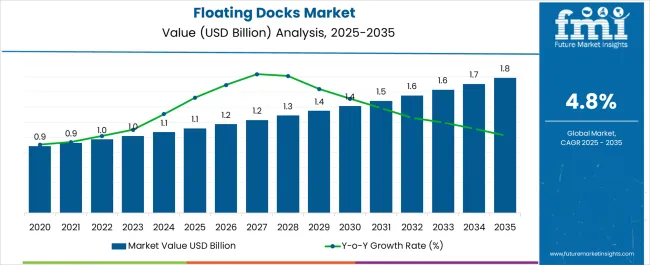
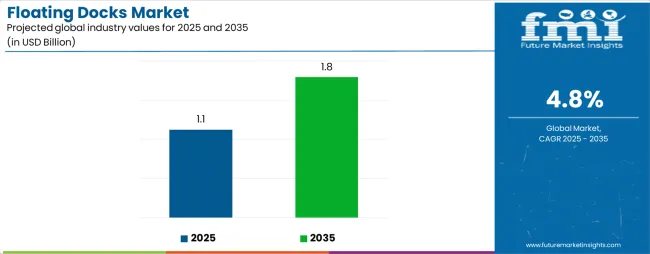
| Metric | Value |
|---|---|
| Floating Docks Market Estimated Value in (2025 E) | USD 1.1 billion |
| Floating Docks Market Forecast Value in (2035 F) | USD 1.8 billion |
| Forecast CAGR (2025 to 2035) | 4.8% |
The Floating Docks market is experiencing steady growth driven by the increasing demand for versatile and modular docking solutions across commercial maritime operations and waterfront developments. The market has benefited from rising investment in port infrastructure, recreational marinas, and waterfront commercial projects that require cost-effective and rapidly deployable docking systems.
Growth has been further supported by advancements in material engineering, allowing floating docks to be constructed with reinforced concrete, which offers enhanced durability, load-bearing capacity, and long service life. The market outlook is influenced by increasing adoption in commercial sectors where permanent fixed structures are less feasible due to tidal variations or water depth fluctuations.
Furthermore, floating docks provide operational flexibility and minimal environmental disruption compared to traditional fixed piers, making them attractive for both new installations and expansions The continued urbanization of coastal areas and the growth of recreational boating and commercial water transport are expected to create additional opportunities, while innovations in modular design, anchoring systems, and maintenance-friendly materials are likely to reinforce sustained market growth over the coming decade.
The floating docks market is segmented by type, application, and geographic regions. By type, floating docks market is divided into Concrete Floating Docks, Metal Floating Docks, Wood Floating Docks, and Plastic Floating Docks. In terms of application, floating docks market is classified into Commercial, Residential, and Industrial. Regionally, the floating docks industry is classified into North America, Latin America, Western Europe, Eastern Europe, Balkan & Baltic Countries, Russia & Belarus, Central Asia, East Asia, South Asia & Pacific, and the Middle East & Africa.
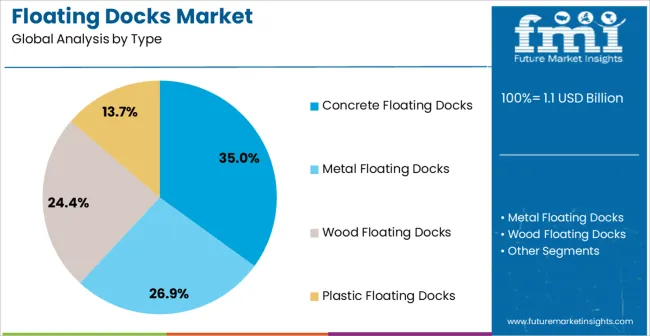
The Concrete Floating Docks type is projected to account for 35.0% of the Floating Docks market revenue in 2025, positioning it as the leading dock type. This segment’s growth has been influenced by the inherent strength, longevity, and structural stability offered by concrete construction, which makes it ideal for heavy commercial usage and harsh marine environments.
The ability of concrete floating docks to withstand variable water levels, high loads, and corrosive conditions has facilitated adoption across ports, marinas, and commercial waterfronts. Additionally, the modular design of these docks allows for easy customization, relocation, and expansion without substantial additional infrastructure, making them suitable for rapidly evolving commercial operations.
Demand has been further supported by reduced long-term maintenance costs, the capacity to integrate safety and accessibility features, and compliance with environmental regulations in sensitive aquatic ecosystems As commercial operators continue to prioritize durability, reliability, and operational efficiency, the concrete floating docks segment is expected to maintain a dominant position in the market while benefiting from innovations in reinforced concrete and modular assembly technologies.
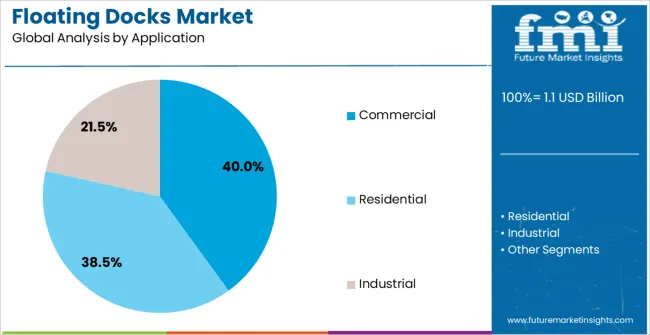
The Commercial application segment is expected to hold 40.0% of the Floating Docks market revenue in 2025, establishing it as the leading application area. Growth in this segment has been driven by the widespread need for docking solutions in shipping terminals, cargo handling facilities, marinas, and other commercial waterfront operations where efficiency, reliability, and scalability are critical. The adoption of floating docks in commercial settings has been accelerated by their ability to accommodate variable water levels, high traffic volumes, and large vessels without the extensive civil work required for fixed docks.
Operational flexibility, lower installation costs, and rapid deployment capabilities have further supported market expansion. The rising focus on safety, accessibility, and minimal disruption to marine ecosystems has reinforced the preference for floating docks over traditional fixed structures.
In addition, commercial operators benefit from modularity, which allows docks to be reconfigured or expanded as operational requirements evolve As global trade and commercial maritime activities continue to grow, the commercial application segment is expected to remain a key revenue contributor, supported by the increasing demand for durable, adaptable, and low-maintenance docking solutions.
A floating dock, also known as dry-dock, is a part of a dock system. It has the ability to submerge to a sufficiently adequate depth, which enables cargo or a vessel to coast in and be anchored in position close to the entryway and push out the water. Another benefit of a floating dock is that proprietors do not need to tie up the dock systems at the harbourfront.
Instead, they can put it on the floating dock. Floating docks are used for residential, commercial and industrial applications for ferry landings, fuelling cargos, helicopter landing pads and others. Furthermore, they are also used for the repair or maintenance of large cargo tankers, carriers or icebreakers.
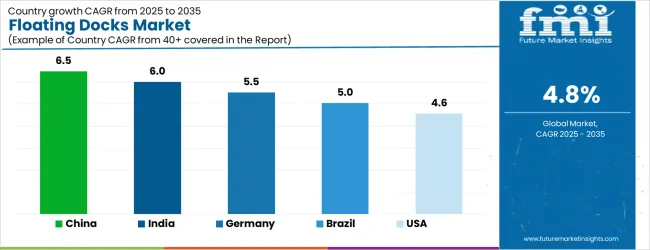
| Country | CAGR |
|---|---|
| China | 6.5% |
| India | 6.0% |
| Germany | 5.5% |
| Brazil | 5.0% |
| USA | 4.6% |
| UK | 4.1% |
| Japan | 3.6% |
The Floating Docks Market is expected to register a CAGR of 4.8% during the forecast period, exhibiting varied country level momentum. China leads with the highest CAGR of 6.5%, followed by India at 6.0%. Developed markets such as Germany, France, and the UK continue to expand steadily, while the USA is likely to grow at consistent rates. Japan posts the lowest CAGR at 3.6%, yet still underscores a broadly positive trajectory for the global Floating Docks Market. In 2024, Germany held a dominant revenue in the Western Europe market and is expected to grow with a CAGR of 5.5%.
The USA Floating Docks Market is estimated to be valued at USD 387.4 million in 2025 and is anticipated to reach a valuation of USD 387.4 million by 2035. Sales are projected to rise at a CAGR of 0.0% over the forecast period between 2025 and 2035. While Japan and South Korea markets are estimated to be valued at USD 52.5 million and USD 37.3 million respectively in 2025.
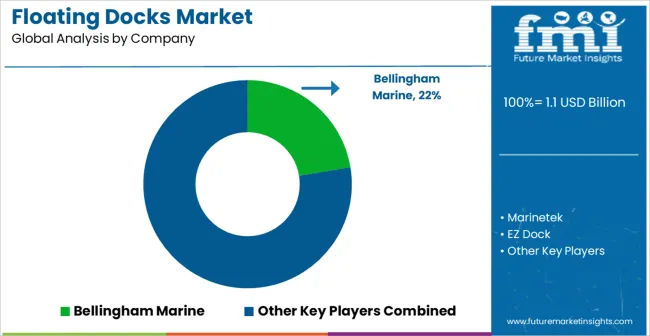
| Item | Value |
|---|---|
| Quantitative Units | USD 1.1 Billion |
| Type | Concrete Floating Docks, Metal Floating Docks, Wood Floating Docks, and Plastic Floating Docks |
| Application | Commercial, Residential, and Industrial |
| Regions Covered | North America, Europe, Asia-Pacific, Latin America, Middle East & Africa |
| Country Covered | United States, Canada, Germany, France, United Kingdom, China, Japan, India, Brazil, South Africa |
| Key Companies Profiled | Bellingham Marine, Marinetek, EZ Dock, SF Marina Systems, Accudock, Candock, Jet Dock Systems, Hisea Dock, and Meeco Sullivan |
The global floating docks market is estimated to be valued at USD 1.1 billion in 2025.
The market size for the floating docks market is projected to reach USD 1.8 billion by 2035.
The floating docks market is expected to grow at a 4.8% CAGR between 2025 and 2035.
The key product types in floating docks market are concrete floating docks, metal floating docks, wood floating docks and plastic floating docks.
In terms of application, commercial segment to command 40.0% share in the floating docks market in 2025.






Full Research Suite comprises of:
Market outlook & trends analysis
Interviews & case studies
Strategic recommendations
Vendor profiles & capabilities analysis
5-year forecasts
8 regions and 60+ country-level data splits
Market segment data splits
12 months of continuous data updates
DELIVERED AS:
PDF EXCEL ONLINE
Floating Fountains Market Size and Share Forecast Outlook 2025 to 2035
Floating Valve Trays Market Size and Share Forecast Outlook 2025 to 2035
Floating Solar PV Market Size and Share Forecast Outlook 2025 to 2035
Floating Covers Market Size and Share Forecast Outlook 2025 to 2035
Floating Offshore Wind Energy Market Size and Share Forecast Outlook 2025 to 2035
Floating Power Plant Market Growth – Trends & Forecast 2025 to 2035
Floating Hotel Industry Analysis by Type, by End User, by Tourist Type, by Booking Channel, and by Region – Forecast for 2025-2035
Market Share Distribution Among Floating Hotel Providers
Floating LNG Power Vessel Market Growth – Trends & Forecast 2024-2034
Solar Floating Pool Lights Market Insights – Trends, Demand & Growth 2025-2035

Thank you!
You will receive an email from our Business Development Manager. Please be sure to check your SPAM/JUNK folder too.
Chat With
MaRIA